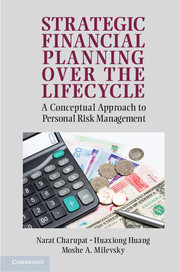Book contents
- Frontmatter
- Contents
- Acknowledgments
- 1 Introduction and Motivation
- 2 Mathematical Preliminaries – Working with Interest Rates
- 3 Personal Balance Sheet and Human Capital
- 4 Consumption Smoothing and Optimal Savings
- 5 Debts, Loans, and Mortgages [Canadian Content]
- 6 Personal Income Taxes [Canadian Content]
- 7 Risk, Utility, and Insurance
- 8 Mortality Risk and Life Insurance
- 9 Investment and Diversification
- 10 The Mathematics of Portfolio Diversification
- 11 Housing Decisions
- 12 Pensions and Retirement [Canadian Content]
- 13 Advanced Material: Part I. Continuous Time and the Calculus of Variations
- 14 Advanced Material: Part II. Stochastic Optimal Control and the HJB Equation
- 15 Concluding Thoughts and Next Steps
- Bibliography
- Index
12 - Pensions and Retirement [Canadian Content]
Published online by Cambridge University Press: 05 June 2012
- Frontmatter
- Contents
- Acknowledgments
- 1 Introduction and Motivation
- 2 Mathematical Preliminaries – Working with Interest Rates
- 3 Personal Balance Sheet and Human Capital
- 4 Consumption Smoothing and Optimal Savings
- 5 Debts, Loans, and Mortgages [Canadian Content]
- 6 Personal Income Taxes [Canadian Content]
- 7 Risk, Utility, and Insurance
- 8 Mortality Risk and Life Insurance
- 9 Investment and Diversification
- 10 The Mathematics of Portfolio Diversification
- 11 Housing Decisions
- 12 Pensions and Retirement [Canadian Content]
- 13 Advanced Material: Part I. Continuous Time and the Calculus of Variations
- 14 Advanced Material: Part II. Stochastic Optimal Control and the HJB Equation
- 15 Concluding Thoughts and Next Steps
- Bibliography
- Index
Summary
Learning Objectives
In this chapter, you will learn about longevity risk or the risk from not knowing the exact length of life. You will see the impact of this risk on the standard of living and on retirement planning. You then look at financial contracts that can provide lifelong income, and thus can be used to hedge longevity risk. Finally, you learn how the risk is dealt with in the consumption-smoothing framework.
Longevity Risk
In most of our analyses so far in this book, we assumed that the age at death D is known with certainty. We know exactly how long a person will spend in his or her retirement. This assumption has facilitated many calculations and made concepts easier to understand. Unfortunately, it is also quite unrealistic. In real life, that length of time varies widely. If you peruse, for example, the obituary section of a newspaper on a given day, you will likely see a wide distribution of ages at death. Figure 12.1 shows the distribution of the number of years after age sixty-five that Canadians (both sexes combined) spent prior to their deaths. The data are from Statistics Canada as of 2007 (the latest year available). The average remaining lifetime is 16.86 years. In other word, the average age at death is 81.86 years old. However, as you can see the distribution is quite dispersed, with a standard deviation of 8.43 years.
- Type
- Chapter
- Information
- Strategic Financial Planning over the LifecycleA Conceptual Approach to Personal Risk Management, pp. 238 - 265Publisher: Cambridge University PressPrint publication year: 2012



